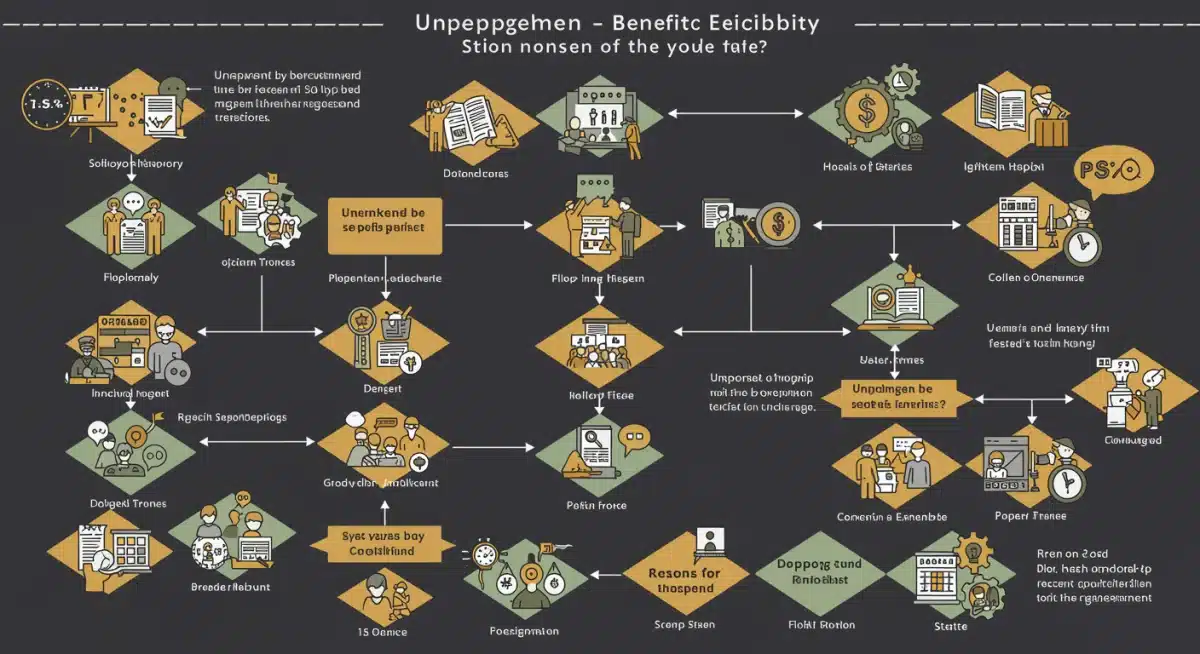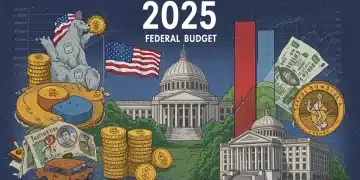Unemployment Benefits 2025: Eligibility, Federal Extensions & Job Seekers

Navigating unemployment benefits in 2025 is essential for job seekers, as eligibility criteria and potential federal extensions remain critical for financial stability during periods of job loss.
For many Americans, understanding unemployment benefits in 2025 is not just a matter of policy, but a practical necessity. Losing a job can be an incredibly stressful experience, bringing with it a cascade of financial and emotional challenges. Fortunately, unemployment insurance programs exist to provide a temporary financial safety net, allowing individuals to focus on their job search without immediate economic collapse. As we look ahead to 2025, it’s vital to grasp the foundational aspects of these benefits, including who qualifies, how to apply, and what potential federal adjustments might be on the horizon.
Understanding the Basics of Unemployment Insurance
Unemployment insurance (UI) is a joint federal-state program designed to provide temporary financial assistance to eligible workers who are unemployed through no fault of their own. Each state administers its own UI program, but all states must adhere to federal guidelines. This means that while there are common threads, the specific rules, benefit amounts, and duration can vary significantly from one state to another. Understanding these fundamental principles is the first step in navigating the system effectively.
State-Specific Regulations and Requirements
Every state has unique requirements that determine eligibility for unemployment benefits. These often include a minimum amount of wages earned during a ‘base period’—typically the first four of the last five completed calendar quarters before filing your claim. Additionally, states will assess the reason for your job separation. Generally, you must be unemployed through no fault of your own, meaning voluntary quits without good cause or terminations due to serious misconduct may disqualify you.
- Wage Requirements: Most states require you to have earned a certain amount of wages during a specified base period.
- Reason for Separation: You must be unemployed due to circumstances beyond your control, such as a layoff or reduction in force.
- Availability for Work: You must be actively seeking new employment and be able and available to work.
Beyond these, states also have specific weekly reporting requirements, where claimants must certify their eligibility and job search activities. Failure to comply with these requirements can lead to delays or even disqualification from benefits. Therefore, it’s crucial to familiarize yourself with your state’s specific Department of Labor or Unemployment Agency website.
In essence, the UI system aims to strike a balance between supporting workers and encouraging reemployment. While the federal government sets broad standards, the granular details are managed at the state level, making localized knowledge invaluable for anyone seeking assistance. This foundational understanding helps set the stage for exploring more complex considerations like federal extensions.
Eligibility Criteria for Unemployment Benefits in 2025
As we approach 2025, the core eligibility criteria for unemployment benefits are expected to remain consistent with established federal and state guidelines. However, it’s always prudent to be aware of any legislative changes that might impact these requirements. Generally, to qualify for unemployment benefits, you must meet specific work and wage requirements, be unemployed through no fault of your own, and be actively seeking new employment.
Work and Wage Requirements
To be eligible, individuals must demonstrate a recent history of employment and earnings. States typically look at a ‘base period’ to determine if you’ve worked enough and earned sufficient wages to qualify. This base period usually covers the first four of the last five completed calendar quarters before you file your claim. The minimum wage thresholds vary significantly by state, so it’s essential to check your state’s specific requirements.
- Minimum Earnings: You must have earned a certain amount of money during your base period.
- Duration of Employment: Some states also consider the length of time you were employed during the base period.
- Covered Employment: Your previous employment must have been with an employer that pays into the state’s unemployment insurance fund.
These requirements are in place to ensure that benefits are provided to individuals who have a legitimate attachment to the workforce. They prevent individuals from claiming benefits if they have not been working consistently or have not contributed sufficiently to the system through their employers’ payroll taxes.
Beyond the financial aspects, the reason for your unemployment is a critical factor. If you were laid off due to a company downsizing, a lack of work, or other economic factors, you are generally considered unemployed through no fault of your own. However, if you quit your job voluntarily without ‘good cause’ (as defined by your state), or if you were fired for ‘misconduct,’ you may be disqualified from receiving benefits. Each state has specific definitions for ‘good cause’ and ‘misconduct,’ which can include things like unsafe working conditions or gross insubordination.

Finally, recipients are typically required to be able to work, available for work, and actively searching for work. This means you must be physically and mentally capable of performing a job, willing to accept suitable employment if offered, and engaging in concrete efforts to find a new position. States often require claimants to keep a detailed log of their job search activities, which can be audited.
Potential Federal Extensions and Their Impact
Historically, federal unemployment benefit extensions have been implemented during periods of high unemployment or economic crisis, such as the Great Recession or the COVID-19 pandemic. These extensions typically provide additional weeks of benefits beyond what states normally offer, and sometimes include enhanced weekly benefit amounts. While the standard state-funded unemployment benefits usually last for 26 weeks, federal extensions can significantly prolong this duration, offering crucial support during prolonged economic downturns.
When Do Federal Extensions Occur?
Federal extensions are not a permanent feature of the unemployment insurance system. They are typically enacted by Congress through specific legislation in response to severe economic conditions. The decision to implement federal extensions is often complex, involving economic indicators, political considerations, and the overall health of the labor market. For 2025, the likelihood of federal extensions will largely depend on the economic forecast and any unforeseen national or global events that could impact employment.
- Economic Recessions: Periods of widespread job loss often trigger federal action.
- High Unemployment Rates: Sustained elevated national unemployment figures are a key indicator.
- Legislative Action: Congress must pass specific laws to authorize and fund these extensions.
Understanding the triggers for these extensions is important for job seekers to monitor. Keeping an eye on national economic news and legislative developments can provide insights into whether additional federal support might become available. These extensions can dramatically alter the financial landscape for those experiencing long-term unemployment.
The impact of federal extensions on job seekers is profound. They provide a much-needed lifeline, allowing individuals more time to find suitable employment without depleting their savings or falling into poverty. This extended support can also help maintain consumer spending, providing a broader economic benefit during challenging times. However, critics sometimes argue that overly long extensions can disincentivize job searching, though evidence on this is mixed and often debated.
For job seekers in 2025, it will be essential to stay informed about any potential federal legislative actions regarding unemployment benefits. While states will continue to manage the primary UI programs, federal interventions can provide a critical additional layer of support when economic conditions warrant it. Staying connected with state unemployment agencies and reliable news sources will be key to understanding if and when these extensions become available.
The Application Process: What Job Seekers Need to Know
Applying for unemployment benefits can seem daunting, but breaking down the process into manageable steps can make it much clearer. The application process typically begins immediately after job loss and generally involves submitting an initial claim to your state’s unemployment agency. While specific requirements vary by state, there are common elements that all job seekers should be prepared for.
Gathering Necessary Documentation
Before you even start the application, gather all relevant documents. This preparation can significantly speed up the process and reduce the chances of delays. Having accurate information readily available is crucial for a smooth application.
- Personal Information: Social Security number, driver’s license or state ID.
- Employment History: Names and addresses of all employers for the last 18 months, dates of employment, and reasons for separation.
- Wage Information: Gross earnings for each employer, severance pay, vacation pay, and pension information.
- Additional Documents: Alien registration card (if not a U.S. citizen), bank account information for direct deposit.
Having these documents at hand will allow you to complete the online application efficiently and accurately. Many states now offer online portals, which are generally the fastest and most convenient way to file your initial claim.
Once your initial claim is filed, the state unemployment agency will review your application and verify your eligibility. This often involves contacting your former employer(s) to confirm the details of your employment and separation. This verification process can take several weeks, during which you might not receive benefits immediately. It is important to continue certifying your eligibility weekly during this period.
After your claim is approved, you will begin receiving weekly benefits, typically through direct deposit or a state-issued debit card. However, the process doesn’t end there. Most states require you to continue certifying weekly that you are still unemployed, able and available to work, and actively searching for new employment. Failing to submit these weekly certifications can result in a suspension of your benefits. Keep detailed records of your job search activities, as these may be requested by the state agency.
Maintaining Eligibility and Avoiding Disqualifications
Receiving unemployment benefits comes with responsibilities. To ensure continuous payments and avoid disqualification, job seekers must adhere to several key requirements. Understanding and consistently meeting these obligations is paramount for anyone relying on this financial support.
Active Job Search Requirements
A fundamental condition for receiving unemployment benefits is that you must be actively seeking new employment. States have varying definitions of what constitutes an ‘active job search,’ but it generally involves taking concrete steps to find a job. This isn’t a passive requirement; it demands genuine effort and documentation.
- Number of Contacts: Most states require a minimum number of job contacts each week.
- Types of Activities: Acceptable activities include applying for jobs, attending job fairs, networking, and participating in resume workshops.
- Record Keeping: Maintain a detailed log of all job search activities, including dates, employer names, contact methods, and outcomes.
Failing to conduct a sufficient job search, or to adequately document it, can lead to your benefits being suspended or even terminated. States regularly audit job search records to ensure compliance, so diligence in this area is crucial. It’s not enough to simply say you’re looking; you must be able to prove it.
Another common reason for disqualification is refusing suitable work. If you are offered a job that is deemed ‘suitable’ based on your skills, experience, and previous wages, and you refuse it without good cause, your benefits may be stopped. The definition of ‘suitable work’ can evolve over time; initially, it might be a job closely related to your previous employment, but as your period of unemployment lengthens, the definition may broaden to include positions with lower pay or different responsibilities.
Furthermore, accurately reporting any earnings is critical. Even part-time or temporary work must be reported to the unemployment agency. Earning income while receiving benefits will typically reduce your weekly benefit amount, but failing to report it can be considered fraud and lead to severe penalties, including repayment of benefits, fines, and even criminal charges. Transparency and honesty throughout the claims process are not just good practice, but legal obligations.
Resources and Support for Job Seekers in 2025
Beyond financial assistance, the unemployment period can be an opportune time for job seekers to enhance their skills, explore new career paths, and leverage available resources. Many government agencies and non-profit organizations offer a wealth of support services designed to help individuals re-enter the workforce more quickly and effectively. Knowing where to find these resources can make a significant difference in your job search journey.
State Workforce Agencies and Career Centers
Your state’s workforce agency or local career centers are invaluable hubs for job seekers. These centers, often funded by federal and state programs, provide a range of free services that can greatly assist in finding new employment. They are designed to be a one-stop shop for everything from resume assistance to job placement.
- Job Matching Services: Access to job boards and direct referrals to employers.
- Resume and Interview Workshops: Professional guidance to polish your application materials and interviewing skills.
- Career Counseling: Assistance in identifying career goals and developing a job search strategy.
- Training Programs: Information on vocational training, certifications, and educational opportunities.
Leveraging these resources can not only improve your chances of finding a job but also help you develop new skills that make you more competitive in the evolving 2025 job market. Many of these services are available online, making them accessible even if you cannot visit a physical location.
In addition to state-provided services, numerous non-profit organizations and community groups offer specialized support. These can range from industry-specific networking groups to organizations focused on helping veterans, individuals with disabilities, or those transitioning from long-term unemployment. Exploring these local resources can provide tailored assistance and a sense of community during a challenging time.
Online platforms also play an increasingly vital role. Websites like LinkedIn, Indeed, and government job boards are essential tools for finding job openings and connecting with potential employers. Many of these platforms also offer skill-building courses and professional development resources. Combining traditional job search methods with digital tools creates a comprehensive approach that maximizes your opportunities in the 2025 employment landscape, enhancing your overall job seeker experience.
Anticipated Changes and Future Outlook for 2025
The landscape of unemployment benefits is rarely static, and 2025 is likely to bring its own set of adjustments and considerations. While the core structure of the federal-state partnership remains, economic shifts, technological advancements, and potential legislative priorities could influence how benefits are administered and accessed. Staying abreast of these potential changes is crucial for job seekers and policymakers alike.
Technological Integration and Streamlined Processes
One area of anticipated change is the continued integration of technology into the unemployment claims process. Many states have already moved towards online applications and digital communication, and this trend is expected to accelerate. This could mean more user-friendly portals, AI-powered assistance for common queries, and improved data analytics to detect fraud more efficiently. For job seekers, this translates to potentially faster processing times and more accessible information, provided they have reliable internet access.
- Enhanced Online Portals: More intuitive and comprehensive digital application systems.
- AI-Powered Support: Chatbots and virtual assistants to guide applicants through the process.
- Data Security Improvements: Continued efforts to protect sensitive personal and financial information.
While technology offers many benefits, it also presents challenges, particularly for individuals who may lack digital literacy or internet access. States will need to ensure that traditional access points, such as phone lines and physical offices, remain available to serve all populations equitably. The goal is to streamline without excluding.
Economically, the outlook for 2025 will heavily influence discussions around benefit duration and potential federal intervention. If the economy remains robust with low unemployment, the focus will likely stay on state-level programs. However, any signs of an economic downturn or significant job market disruption could trigger renewed calls for federal extensions or new temporary programs. The flexibility of the UI system to adapt to varying economic conditions is one of its inherent strengths.
Legislatively, there could be ongoing debates about modernizing the unemployment insurance system. Discussions often revolve around expanding coverage to gig workers, adjusting benefit amounts to better reflect living wages, or reforming the financing structure of the program. While major overhauls are often slow-moving, incremental changes could still impact those seeking benefits in 2025. Job seekers should remain informed through official government channels and reputable news sources to understand how these evolving factors might affect their eligibility and support.
| Key Aspect | Brief Description |
|---|---|
| Eligibility Criteria | Must meet state-specific work/wage history, be unemployed through no fault of your own, and actively seek work. |
| Federal Extensions | Temporary additional weeks of benefits, typically enacted by Congress during severe economic downturns or high unemployment. |
| Application Process | Gather documents, file initial claim online/in-person, certify weekly, and actively search for jobs. |
| Available Resources | State workforce agencies, career centers, and online platforms offer job search assistance and training. |
Frequently Asked Questions About Unemployment Benefits in 2025
To qualify for unemployment benefits in 2025, you must generally have sufficient work and wage history in your state’s base period, be unemployed through no fault of your own, and be able and available to work while actively seeking new employment. Specific wage thresholds and work duration vary by state.
Federal unemployment extensions are not a permanent feature and are typically enacted by Congress during periods of significant economic downturn or high national unemployment. The availability of federal extensions in 2025 will depend on future economic conditions and legislative decisions made by Congress.
You apply for unemployment benefits through your state’s unemployment agency, usually online. You’ll need personal information, employment history, and wage details. After filing your initial claim, you’ll typically need to certify your eligibility weekly and document your job search activities to continue receiving benefits.
Refusing a suitable job offer without good cause can lead to disqualification from unemployment benefits. The definition of ‘suitable work’ can vary by state and may broaden the longer you are unemployed. Always report job offers to your state agency and understand the implications of refusal.
Numerous resources are available, including state workforce agencies and local career centers offering job matching, resume workshops, career counseling, and training programs. Online platforms like LinkedIn and Indeed also provide extensive job listings and professional development tools to aid your job search.
Conclusion
Navigating the complexities of unemployment benefits in 2025 requires a proactive and informed approach. From understanding core eligibility criteria and the nuances of state-specific regulations to staying updated on potential federal extensions, job seekers must be diligent. The application process, coupled with the ongoing responsibility of maintaining eligibility through active job searches, forms the backbone of receiving this vital financial support. Fortunately, a wealth of resources, including state workforce agencies and online platforms, are available to assist individuals in their journey back to employment. By leveraging these tools and remaining informed about the evolving economic and legislative landscape, job seekers can effectively manage their transitions and secure a stable financial future.





